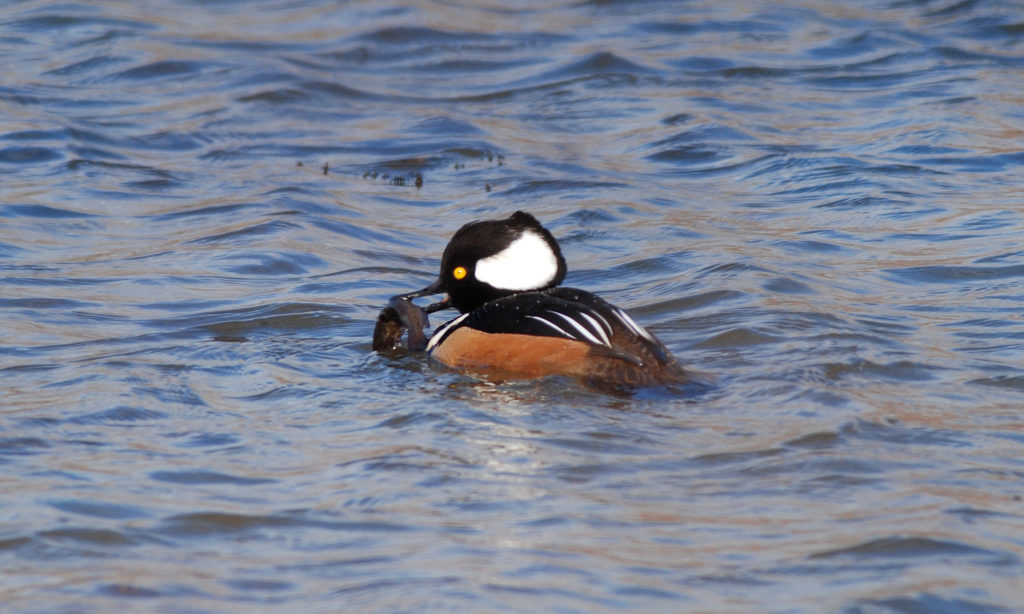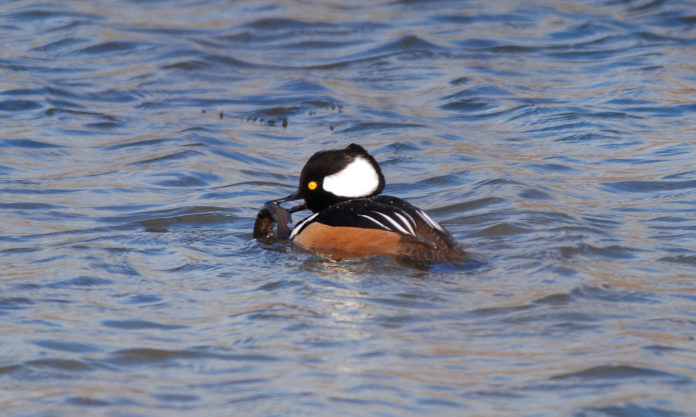By Jay Watson, Co-Executive Director of New Jersey Conservation Foundation

If we say someone’s an “odd duck,” it means they have a quirky personality or unusual habits. The expression comes from the Hans Christian Andersen fairy tale, “The Ugly Duckling,” in which (spoiler alert!) the little duck who doesn’t fit in with the rest of the flock is actually a swan.
But when we say “weird duck,” it means something else entirely. In birder slang, weird ducks are the waterfowl from the far north that migrate to warmer places, including New Jersey, in the winter. In appearance and behaviors, they’re different from the state’s year-round ducks and those that breed here in the summer.
New Jersey has about 20 weird ducks that are regular winter visitors, including buffleheads, gadwalls, mergansers, scaups, eiders, teals, wigeons, canvasbacks and harlequins. They’re all fascinating to watch, and can be spotted in a variety of places across the state. Some head for freshwater marshes, lakes, and rivers, while others like the ocean, bays and inlets along the coast.
Do you have to be an odd duck to go out searching for weird ducks in winter? Not at all! Birding is one of the best ways to get outdoors for fresh air and exercise, and is excellent for both physical and mental health.
Perhaps the cutest of the weird ducks is the bufflehead, a small diving duck named for the shape of a buffalo’s head. Buffleheads winter in bays, estuaries, reservoirs, and lakes, spending about half their time underwater feeding on crustaceans, mollusks and insect larvae. From a distance, males appear to be a striking black-and-white, but a closer look reveals iridescent green and purple patches on their heads. Females are a subdued gray-brown with a white patch on the cheek.
Another fun duck to spot is the hooded merganser, whose spectacular fan-shaped crests can give them a look of surprise – like hair standing on end. Males have a black head with a prominent white patch, while females have a pretty cinnamon-brown crest. Hooded mergansers are commonly seen on small ponds and rivers, where they dive and use their serrated bills to catch fish, crayfish, and other food.
The harlequin duck is another beautiful winter visitor – a sea duck that likes to gather along rocky shorelines. Male harlequins are boldly patterned in hues of slate gray, white and chestnut, while females are a drab brown with distinctive white spots on their heads. One of the best spots to find harlequins is the ocean off Barnegat Light State Park, where they dive in search of aquatic invertebrates and small fish.
Another cool winter duck is the Northern shoveler, distinctive for its large, spoon-shaped bill. Shovelers are usually found in marshes, and their bills have fine projections along the edges that act like a sieve, allowing them to scoop tiny crustaceans, seeds, and aquatic invertebrates out of the water. In their breeding plumage, males have a shiny green head, white chest and reddish-brown flanks.
While searching the marshes, you might also spot the graceful Northern pintail. True to their name, pintails swim with their long, pointed tails held high. Males have a chocolate brown head, white breast and neck stripes, and a tan back. Females have tan heads and brown patterned markings. Large flocks of pintails gather in wetlands, lakes, and bays in winter. You may also see them waddling through farm fields in search of grains.
Ready to go out looking for weird ducks? If you’re not sure where to start, you may want to try an organized birding trip.
On Saturday, Feb. 3, a winter waterfowl walk will be held from 10 a.m. to noon at Roebling Park in Hamilton Township. The group will walk around Spring Lake, part of the larger Abbott Marshlands complex. The free walk is being organized by the Friends for the Abbott Marshlands, and co-sponsored by the Mercer County Park Commission. To register, go to https://abbottmarshlands.org/event/first-saturday-wellness-walk-roebling-park-4/.
On Saturday, Feb. 10, New Jersey Conservation Foundation and the Feminist Bird Club of Jersey City will lead a free walk to look for weird ducks at Richard W. DeKorte Park in Lyndhurst from 9 to 11 a.m. No experience is necessary, and extra binoculars and a spotting scope will be available to share. Free parking is available and the park has several accessible trails, including a boardwalk wide enough for wheelchairs, as well as two flat, non-rocky trails. To register, go to https://www.njconservation.org/event/weird-ducks/.
If you want to try finding winter waterfowl on your own, places like Liberty State Park, the Great Swamp National Wildlife Refuge, the Gateway National Recreation Area at Sandy Hook, the Abbott Marshlands, and the South Cape May Meadows are all good bets. Along the coast, try visiting the various ocean inlets, including the Shark River, Manasquan and Barnegat inlets. Wherever you go, dress warmly and think about all of the various species that migrate through, stop to breed or call this state of ours home all year long.
To learn where others are spotting weird ducks in New Jersey, check the e-Bird portal at https://ebird.org/region/US-NJ. Many dedicated birders regularly report their sightings and post photos on e-Bird.
Get out and see the weird ducks while you can! Once spring arrives, they’ll be heading back north – often as far as the arctic – for their breeding seasons.
And for information on preserving New Jersey’s land and natural resources – including great places for birding – visit the New Jersey Conservation Foundation website at www.njconservation.org or contact me at [email protected].


